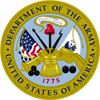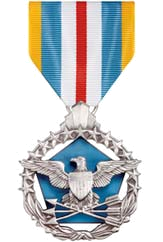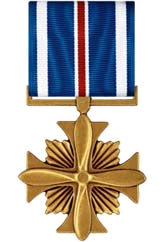Legion of Merit — Military Decorations
Legion of Merit Medal and Ribbon Design Images

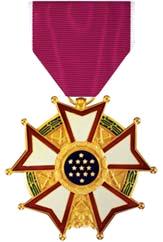
The Chief Commander Degree of the Legion of Merit Medal is, on a wreath of green laurel joined at the bottom by a gold bow-knot (rosette), a domed five-pointed white star bordered crimson, points reversed with v-shaped extremities tipped with a gold ball. In the center, a blue disk encircled by gold clouds, with 13 white stars arranged in the pattern that appears on the Great Seal of the United States. Between each point, within the wreath are crossed arrows pointing outwards. The words ""UNITED STATES OF AMERICA"" are engraved in the center of the reverse. A miniature of the decoration in gold on a horizontal gold bar is worn on the service ribbon. The Commander Degree of the Legion of Merit Medal is, on a wreath of green laurel joined at the bottom by a gold bow-knot (rosette), a five-pointed white star bordered crimson, points reversed with v-shaped extremities tipped with a gold ball. In the center, a blue disk encircled by gold clouds, with 13 white stars arranged in the pattern that appears on the Great Seal of the United States. Between each star point, within the wreath, are crossed arrows pointing outwards. A gold laurel wreath in the v-shaped angle at the top connects an oval suspension ring to the neck ribbon. The reverse of the five-pointed star is enameled in white, and the border is crimson. In the center, a disk for engraving the name of the recipient surrounded by the words ""ANNUIT COEPTIS MDCCLXXXII."" An outer scroll contains the words ""UNITED STATES OF AMERICA."" A miniature of the decoration in silver on a horizontal silver bar is worn on the service ribbon. The neck ribbon for the degree of Commander consists of the following stripes: 1/16 inch white; center 1 13/16 inches crimson, and 1/16 inch white. The Officer Degree of the Legion of Merit Medal is similar to the degree of Commander except the overall width is slightly smaller and the pendant has a suspension ring instead of the wreath for attaching the ribbon. A gold replica of the medal is centered on the suspension ribbon. The Legionnaire Degree of the Legion of Merit Medal and the Legion of Merit Medal issued to U.S. personnel is the same as the degree of Officer, except the suspension ribbon does not have the medal replica.
What is the Legion of Merit Decoration?
The ribbon for all of the decorations is 1 3/8 inches wide and consists of the following stripes: 1/16 inch (white; center 1 1/4 inches crimson; and 1/16 inch white. The reverse of all of the medals has the motto taken from the Great Seal of the United States, "ANNUIT COEPTIS" ("He [God] has favored our undertakings") and the date "MDCCLXXXII" (1782) which is the date of America's first decoration, the Badge of Military Merit, now known as the Purple Heart. The ribbon design also follows the pattern of the Purple Heart ribbon.
The United States military sorts decorations into categories called Classes and Types. The Legion of Merit medal is classified as a Personal Decoration of the type Distinguished Service Medal.
How Do You Earn the Legion of Merit?
The Legion of Merit, also known as LOM is a military award that is given for exceptionally meritorious conduct in the performance of one’s duty. The decoration is issued to members of uniformed services of the United States as well as military and political figures of foreign governments.
It may also be awarded to officers of lesser rank, senior warrant officers who are typically in command positions at the rank of CW5. It may also be awarded to very senior enlisted personnel who are typically in the rank of CSM and SMA in the Army, FLTCM and MCPON in the Navy, CMSAF in the Air Force and SgtMajMC in the Marine Corps. However, these instances are less frequent, typically by exception, and the circumstances vary by branch of service.
Authority to award the Legion of Merit is reserved for general officers and flag officers in pay grade O-9 (e.g., Lieutenant General and Vice Admiral) and above, civilian Department of Defense personnel at assistant service secretary or Assistant Secretary of Defense level and above, or equivalent secretary-level civilian personnel with the Department of Homeland Security with direct oversight of the U.S. Coast Guard.
There are multiple degrees for which the award can be given. The degrees of Chief Commander, Commander, Officer, and Legionnaire are awarded only to members of armed forces of foreign nations under the criteria outlined in Army Regulation 672-7 and is based on the relative rank or position of the recipient as follows:
- Chief Commander: Head of state or government. However, this degree was awarded by President Roosevelt to some Allied World War II theater commanders, usually for joint amphibious landings or invasions.
- Commander: Equivalent of a U.S. military chief of staff or higher position, but not to a head of state.
- Officer: General or flag officer below the equivalent of a U.S. military chief of staff; colonel or equivalent rank for service in assignments equivalent to those normally held by a general or flag officer in U.S. military service; or military attachés.
- Legionnaire: All recipients not included above.
When the Legion of Merit is awarded, however, it is awarded without reference to degree. The criteria are "for exceptionally meritorious conduct in the performance of outstanding services and achievements" and is typically reserved for senior officers at O-6 level and above.
- The performance must have been such as to merit recognition of key individuals for service rendered in a clearly exceptional manner.
- Performance of duties normal to the grade, branch, specialty, or assignment, and experience of an individual is not an adequate basis for this award.
- For service not related to actual war, the term "key individual" applies to a narrower range of positions than in time of war and requires evidence of significant achievement.
- In peacetime, service should be in the nature of a special requirement or of an extremely difficult duty performed in an unprecedented and clearly exceptional manner.
- However, justification of the award may accrue by virtue of exceptionally meritorious service in a succession of important positions.
Displaying the Legion of Merit
The Order of Precedence of the Legion of Merit is 14, and this precedence is used when placing the associated service ribbon on your uniform ribbon rack. You can see a full list of decorations in the order of precedence on the Decorations homepage.
The Legion of Merit is one of only two United States military decorations to be issued as a neck order. The only other award is the Medal of Honor. It is the only United States military decoration which may be issued in award degrees.The Legion of Merit is sixth in the order of precedence of U.S. military awards. It is worn after the Defense Superior Service Medal and before the Distinguished Flying Cross. Additional awards:The U.S. Air Force limits the Legion of Merit to four awards per career.Additional awards of the Legion of Merit are denoted by oak leaf clusters (in the Army and Air Force), and by 5/16 inch (7.9 mm) gold stars (in the Navy, Marine Corps, and Coast Guard). The sea services (i.e., the Navy, Marine Corps, and Coast Guard) may also authorize the Combat "V" for wear on the LOM, while the Army and Air Force do not authorize the "V" device.The degrees and the design of the decoration were influenced by the French Legion of Honour (Légion d’honneur).
Legion of Merit Associated Branches
Army |
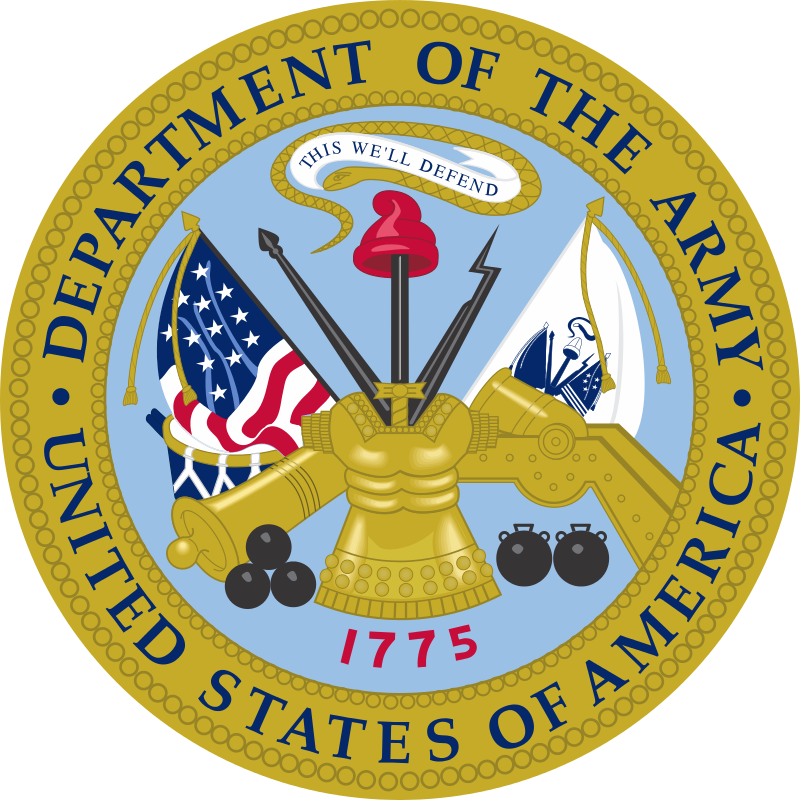 |
Navy |
 |
Marine Corps |
 |
Air Force |
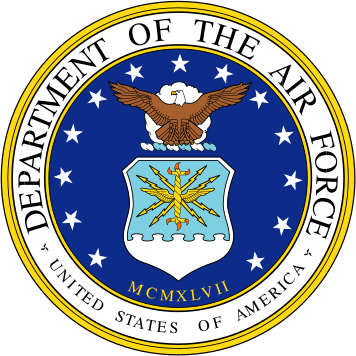 |
Coast Guard |
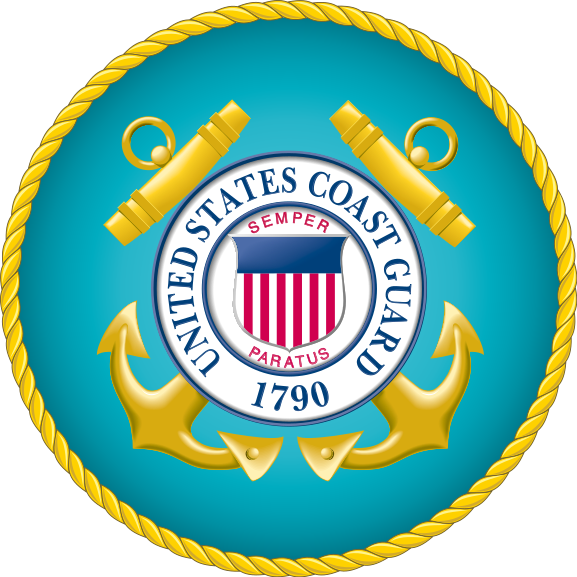 |
Legion of Merit Associated Branches
Army |
 |
Navy |
 |
Marine Corps |
 |
Air Force |
 |
Coast Guard |
 |
Legion of Merit and the Stolen Valor Act
The Stolen Valor Act of 2013 is a federal law that makes it illegal for any person to falsely claim to be the recipient of certain military awards, "with the intention of obtaining money, property, or other tangible benefit by convincing another that he or she received the award".This decoration is covered by the Stolen Valor act. Fraudulently claiming to have received a Legion of Merit can result in punishment including a fine, imprisonment for not more than one year, or both

























